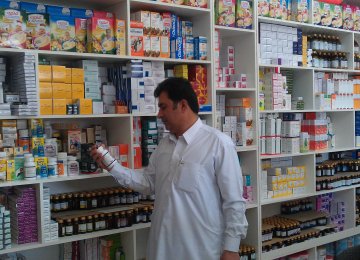Currently there is no shortage of essential drugs and the domestic pharmaceutical sector is out of the woods, according to Dr. Kheyrollah Gholami, head of the chain of pharmacies under the 13-Aban Pharmacy, a community pharmacy operated by the Department of Clinical Pharmacy, College of Pharmacy affiliated to Tehran University of Medical Sciences.
“The crisis in the pharmaceutical sector is over, and the local demand for medicine is now being met effectively,” he told ILNA on Sunday.
Incidence of drug shortages in Iran is usually reflected in the 13-Aban Pharmacy shortage reports. The reports contain important information on the availability of medicines. Drug shortages can frustrate the drug therapy process and increase the probability of medical complications due to the lack of timely supply of medications.
There was a critical shortage of drugs, particularly life-saving medicines for hard-to-treat and rare diseases including cancer, close to the end of the previous administration in 2013.
The health of many people was compromised due to the shortage of imports of medicines not produced locally. It was also compounded by the western sanctions (over Iran’s nuclear program) despite the fact that under international conventions food and medicine is exempt from trade or any other restrictions imposed on governments. The impact of the sanctions on Iran’s international banking ties was overwhelming.
The Iranian Hemophilia Society (HIS) said in August 2012 that “the lives of tens of thousands of children are endangered by the lack of proper drugs due to the international economic sanctions” spearheaded by the US government. During 2009-2012, a number of local pharmacies closed as a result.
Things took a turn for the better when the issue was addressed by the Rouhani administration soon after it took office in 2013 and extra foreign exchange was allocated for medicine imports. Since January 2016, most international sanctions have been lifted after Iran signed a landmark nuclear agreement with six world powers (five permanent members of the UN Security Council plus Germany).
Dealing With Shortage
The College of Pharmacy, Tehran University of Medical Sciences, established seven community pharmacies in the 1980s that are the major suppliers of medicine in Tehran. The pharmacies have contracts with all the main Iranian health insurance companies and process about 3,500 prescriptions per day.
Moreover, they play an important role in the management of deficit drugs, whose distribution is usually centralized in the pharmacies to overcome insufficient supplies, ensure equitable supply and curb smuggling and misuse. Therefore, shortage reports of 13-Aban Pharmacy are an alarm bell for the Health Ministry on the status, strengths and weaknesses of the national drug policy.
According to officials at the Food and Drug Administration (FDA), almost all essential medicines are now available in the market.
“Around 2,200 medicines are produced in the country while 690 are imported,” said Shahriar Eslami Tabar, general director of legal affairs at the FDA, Borna news reported.
About 96% of the domestic demand for medicine is met by 62 local pharmaceutical companies. Each year, $250 million is earmarked for production of medications, including import of raw materials and packaging.
Except for a few extremely rare drugs, which could be the case anywhere across the world, the domestic market is self-reliant.
Expenditure on imports that have equivalents in the domestic pharmaceutical sector has been reduced from $600 million in 2012 to $200 million in 2015, with the aim to support domestic production.






Add new comment
Read our comment policy before posting your viewpoints